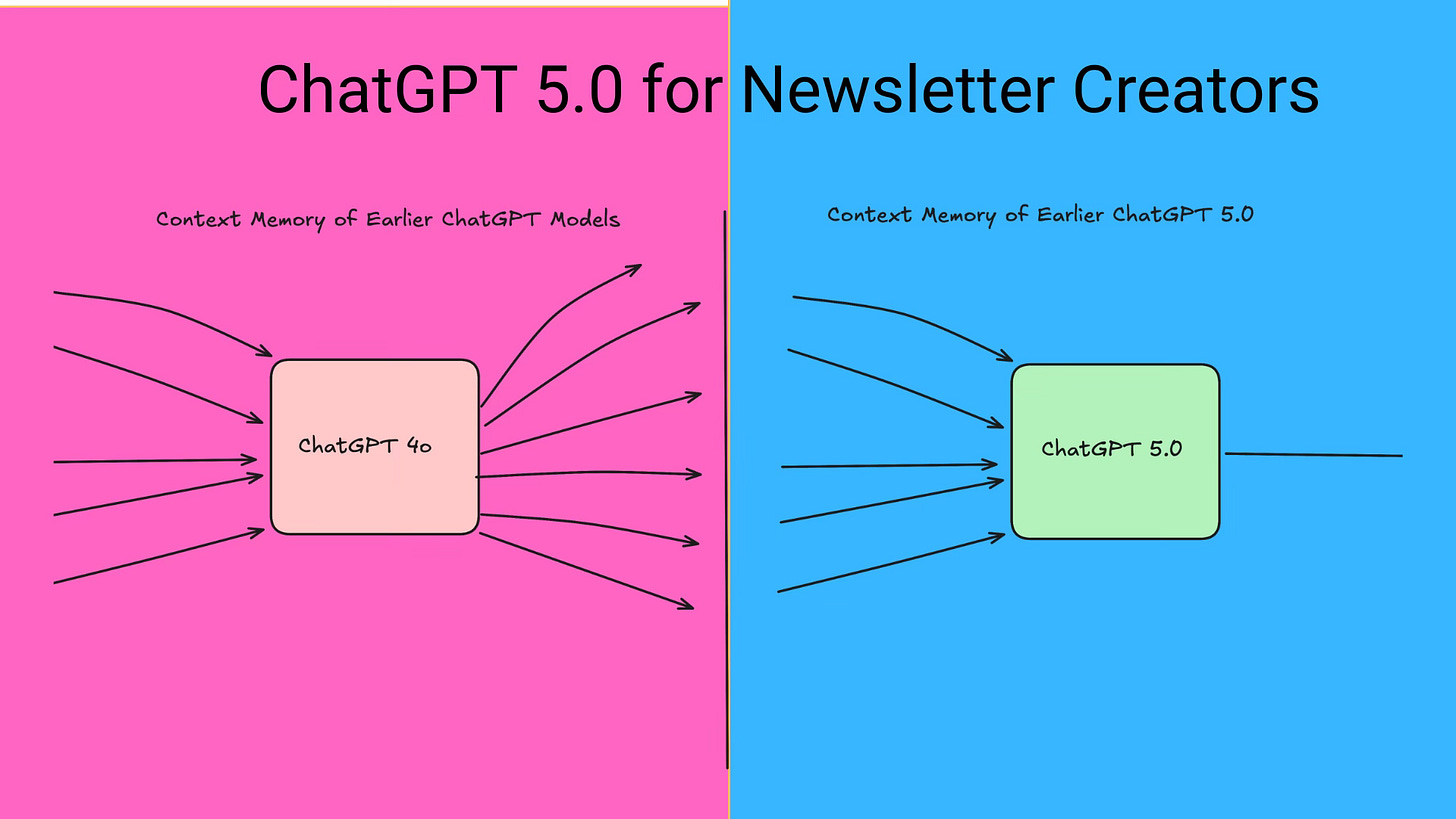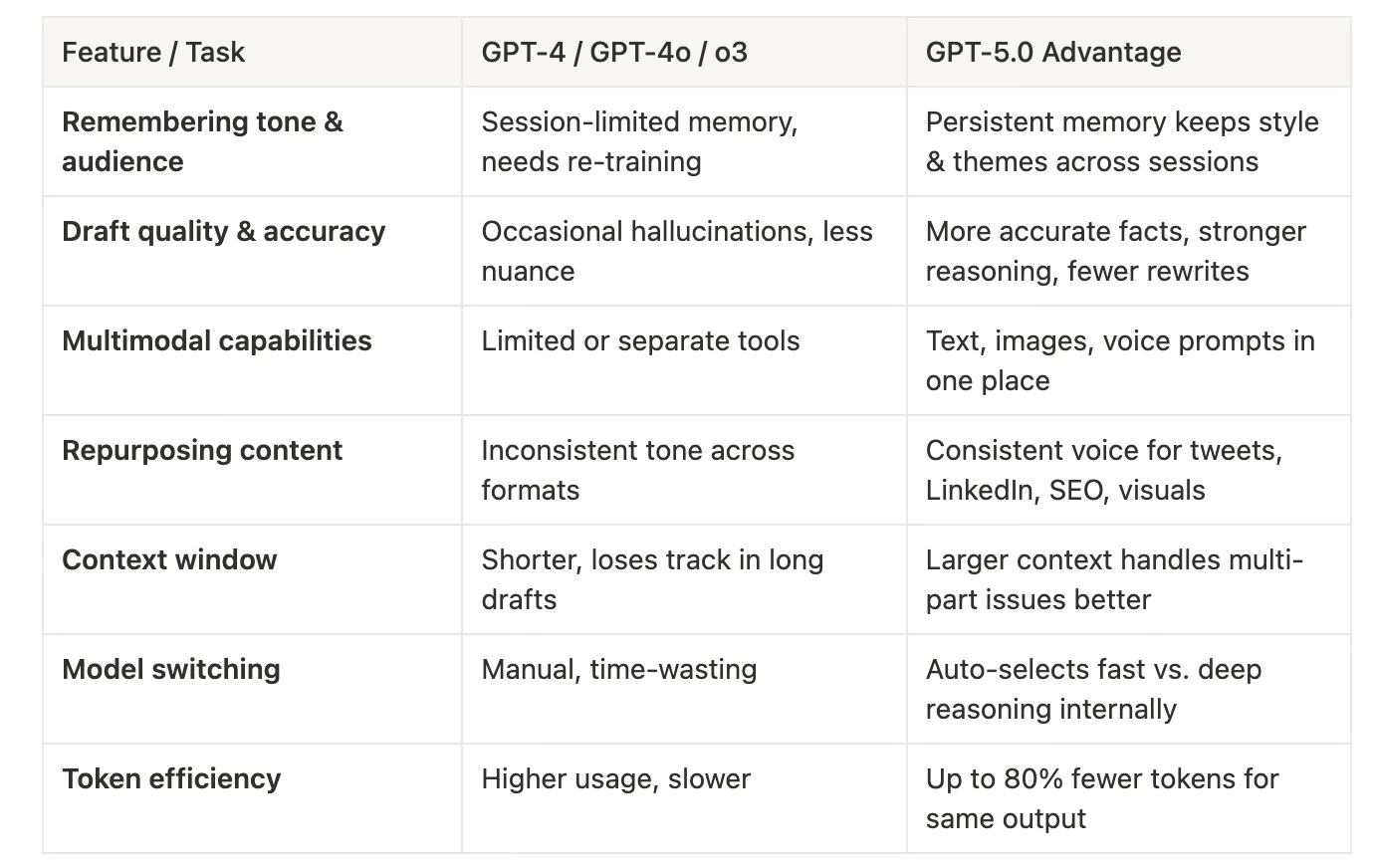Why ChatGPT 5.0 Is the Ultimate Game-Changer for Newsletter Creators
and 3 Key features I am using with this
Last month, I watched a fellow Substack creator burn out trying to "do it all."
4 hours brainstorming topics , 2 more hours drafting
Another hour breaking it into tweets, LinkedIn posts, and SEO snippets
By the time they hit "Publish," they were too exhausted to promote it.
Here's what's really killing newsletter growth: It's not lack of ideas. It's repetition, context loss, and workflow bloat.
I've tested GPT-4, GPT-4o, and o3 for my own newsletter — and while they were good, they couldn't solve these three problems.
ChatGPT 5.0 finally does.
🧠 Problem 1: Losing My Voice & Context Every Time
My experience with older models:
Session amnesia: GPT-4 & GPT-4o forgot my tone, audience preferences, and writing style between sessions
Constant re-training: Had to paste old newsletter issues and my detailed "tone guide" into every single chat
Mid-conversation drift: Even within long drafts, the AI slowly shifted from my personal voice to generic corporate speak
Why this happened:
The older models had limited session memory and no persistent learning. They treated every conversation as completely new, with zero context about your writing history, audience, or style preferences. It's like hiring a new ghostwriter every single day who has never read your work.
How GPT-5.0 fixes it:
Persistent Memory Architecture: GPT-5.0 stores and recalls your writing patterns, audience insights, and style preferences across all sessions. It builds a comprehensive profile of your voice that gets stronger with each interaction.
Context Continuity: Instead of starting fresh every time, it maintains awareness of your newsletter history, successful topics, reader engagement patterns, and evolving style preferences.
Voice Consistency Engine: Advanced algorithms ensure your tone remains consistent throughout entire pieces, preventing the gradual drift that plagued older models.
How you should use it:
Initial Setup (One Time Only):
Learn my writing style from these 3 newsletter examples: [paste examples]
My audience: Early-stage founders aged 25-40 struggling with product-market fit
My tone: Conversational, slightly witty, story-driven with actionable takeaways
My structure preference: Hook → Personal story → Lesson → Clear CTA
Remember this for all future conversations.
Regular Writing Sessions:
Draft a newsletter on "Finding your first 100 customers" using my established voice and audience understanding.
Include:
- Personal anecdote from my startup days
- 2 actionable tactics readers can implement this week
- Conversational tone with strategic insights
- 800 words with clear section breaks
The result: Zero setup time in future sessions. Just jump straight into creating content that sounds authentically like you.
⚡ Problem 2: Turning One Draft into Multiple Formats
My experience with older models:
Voice fragmentation: Each format (newsletter, tweets, LinkedIn) sounded like different people wrote it
Tool juggling: Newsletter in ChatGPT, image prompts in DALL-E, social copy in Claude - constant switching
Time multiplication: 30-minute repurposing task became 2+ hours of tool-switching and consistency fixes
Why this happened:
Older models lacked multimodal integration and couldn't maintain voice consistency across different content formats. Each tool operated in isolation, with no understanding of your overall brand voice or content strategy. You were essentially starting from scratch for each format.
How GPT-5.0 fixes it:
Unified Multimodal Creation: GPT-5.0 generates text, images, audio scripts, and social content in one conversation, maintaining your voice across every format. It understands how your newsletter tone should adapt for Twitter's brevity or LinkedIn's professional context while staying authentically you.
Voice Consistency Engine: Advanced algorithms ensure your personality, key messages, and brand voice translate perfectly across all content types. Your Twitter threads will feel like condensed versions of your newsletter, not generic social media posts.
Context Preservation: Key insights, analogies, and examples from your main content get intelligently adapted for each format rather than lost in translation.
How you should use it:
All-in-One Repurposing:
From this newsletter draft, create a complete content package:
1. Email subject lines: 3 options under 50 characters that create curiosity
2. Twitter thread: 8 tweets that tell the story without spoiling the conclusion
3. LinkedIn post: 200 words with professional hook but keep my conversational style
4. Instagram caption: Story-driven with emotional hook, include 5 relevant hashtags
5. SEO meta description: 160 characters optimized for "newsletter growth tips"
6. DALL-E image prompt: Visual that captures the main metaphor in my article
7. Podcast intro script: 60-second teaser in my speaking style
Maintain my voice across all formats while adapting to each platform's requirements.
The result: 7 pieces of cohesive content that all sound unmistakably like you, created in one 15-minute conversation instead of 2+ hours of tool-switching.
🚀 Problem 3: Switching Models & Losing Momentum
My experience with older models:
The model shuffle: Used GPT-4 for deep thinking, GPT-4o for speed, o3 for analysis - constant switching
Context death: Every model switch meant starting over and losing the entire conversation thread
Creative momentum killer: Just when ideas flowed, I'd hit a wall and need to switch tools
Grab a copy of my 48 Prompt Framework Library - [Access here]
Why this happened:
Each model was optimized for specific tasks but couldn't handle the full spectrum of newsletter creation. You needed GPT-4's reasoning for strategy, GPT-4o's speed for drafting, and o3's analysis for data verification. But they couldn't talk to each other, forcing you to rebuild context every time.
How GPT-5.0 fixes it:
Intelligent Auto-Switching: GPT-5.0 seamlessly transitions between "fast mode" for quick tasks and "thinking mode" for complex reasoning without you deciding. It automatically determines when to prioritize speed versus depth based on your request.
Uninterrupted Context Flow: Maintains complete conversation history and creative momentum regardless of which processing mode it uses. Your ideas, references, and creative direction stay intact throughout the entire session.
Unified Intelligence: Combines the strategic thinking of GPT-4, the speed of GPT-4o, and the analytical power of o3 into one model that uses up to 80% fewer tokens while delivering superior results.
How you should use it:
Strategic Content Planning:
Plan my next month of newsletter content using my audience insights and past performance data.
For each week, provide:
- Strategic topic selection based on my readers' journey stage
- Content angle that builds on previous newsletters
- Key research points and data I should include
- Promotion strategy across my channels
- Success metrics to track
Think deeply about audience development strategy, but keep the output concise and actionable.
Seamless Creation to Distribution:
Take me from blank page to published newsletter for the topic "Why most startups fail at customer discovery."
Do this in phases:
1. First, outline the strategic approach and key arguments
2. Then write the full draft in my established voice
3. Finally, create all repurposed content for social media and SEO
Handle the deep thinking and quick execution seamlessly - I shouldn't need to prompt you to switch modes.
The result: One conversation that flows from strategic thinking to creative writing to tactical execution, maintaining full context and creative momentum throughout the entire process.
To supercharge this, I am sharing my Prompt frameworks that I use for my use case
Grab a copy of my AI Writing Blueprint - [Access here]
Grab a copy of my 48 Prompt Framework Library - [Access here]
Conclusion:
GPT-5.0 solves the biggest newsletter creator challenges by remembering your voice, preserving context, and reducing workflow complexity.
It unifies content creation across formats, keeping your tone consistent while saving hours of tool-switching and repurposing.
With intelligent auto-switching and persistent memory, GPT-5.0 empowers you to focus on authentic audience connection and sustainable growth.




Am I the only one seeing using AI like Sauron’s rings of power? Sure they can instantly do anything for us better and better each day. But why read your ChatGPT content when I can auto generate anything I want already?
I agree that ChatGPT will help uninspired and unimaginative newsletter editors and writers create banal, vanilla newsletters that will all begin to sound the same after a while. I’ve written government documents that made me feel like shooting myself (so I could get disability) because of their strict formatting requirements and I’ve written some really interesting (to me) pieces of fiction. If you consider yourself a creative writer, an artist, I recommend staying away from using any kind of AI. It’s like using a respirator to breathe when you can breathe well on your own. It will only become a crutch, an addiction, and your creativity will suffer greatly.